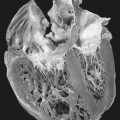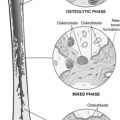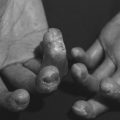71. Pulmonary Alveolar Proteinosis
Definition
Pulmonary alveolar proteinosis (PAP) is a rare lung disease characterized by filling of the distal alveoli with endogenous proteinaceous or floccular material derived from surfactant phospholipids and protein components. This disease presents in two forms: primary (idiopathic) or secondary (resulting from infection, hematologic malignancy(ies) or inhalation of a foreign substance).
Incidence
The incidence of PAP is estimated to be 1:100,000. Males are affected more often by a ratio of 4:1.
Etiology
The etiology of primary PAP is still not known. Secondary PAP is associated with several processes, which lends credence to a causal relationship. The associated processes include inhalation of inorganic/mineral dusts (e.g., silica, titanium oxide, aluminum) or organic materials (e.g., insecticides); hematologic malignancy(ies); myeloid, lysinuric protein intolerance, or HIV infection.
Signs and Symptoms
• Clubbing of digits
• Cor pulmonale (rare)
• Cyanosis (rare)
• Fatigue
• Fine end-inspiratory crackles
• Hemoptysis (rare)
• Intermittent low-grade fever
• Intermittent night sweats
• Malaise
• Persistent dry cough
• Pleuritic chest pain
• Progressive dyspnea
• Pulmonary hypertension
• Weight loss
Medical Management
Medical care of the patient with primary PAP is predicated on the presence or absence of a coexisting infection, the extensiveness of progression of the disease, as well as the degree of physiologic impairment. In the past, treatment consisted of administration of corticosteroids, aerosolized mucolytics, and aerosolized proteinases, but success in this treatment regimen was limited.
The current standard of care for treating the patient with PAP is whole-lung lavage to mechanically remove the accumulated lipoproteinaceous materials. Whole-lung lavage requires general anesthesia via a double-lumen endobronchial tube. Placement of the tube makes it possible to lavage one lung while ventilating the other. Both lungs are first ventilated for several minutes with 100% oxygen. One lung is then isolated and lavaged with 0.9% isotonic saline solution. The saline remains in the lung for a few minutes and is suctioned out as completely as possible. The treated lung is allowed to recover, usually for a period of several days, after which general anesthesia is employed and the process repeated for the other lung.
Complications
• Cor pulmonale
• Lung infections
• Pulmonary fibrosis
Anesthesia Implications
The patient should have pulmonary function testing (PFT) done before the administration of any proposed anesthetic, whether for whole-lung lavage or any other surgical intervention. The results of the PFTs can identify a restrictive lung disease with reduced lung volumes, altered lung compliance, and/or decreased diffusing capacity. The anesthetist should strive to keep peak inspiratory pressures as low as possible, which can be aided by selection of the pressure-controlled ventilation mode on many newer anesthesia machines. In addition, the patient should be placed on a prolonged expiratory phase during ventilation, on the order of 1:2.5 or 1:3. Both measures are aimed at maximizing the patient’s gas exchange while limiting or preventing air trapping and potential lung injury.
The patient scheduled for whole-lung lavage requires a double-lumen endobronchial tube. Preoxygenation should be longer than usual because of the restrictive nature of PAP as well as the longer time needed, generally, for placement and confirmation of tube placement, along with the increased pulmonary shunting typically found in PAP patients.
The patient with PAP should have an arterial pressure line inserted before the proposed procedure. Serial blood gas analysis samples should obtained, beginning preoperatively, to establish the patient’s baseline, and thereafter to mark the progress of the treatment and ventilatory adequacy.
The patient undergoing whole-lung lavage may benefit from the use of total intravenous anesthesia (TIVA), in part because of the reduced lung area that will be available for the provision of an inhalational agent. Whole-lung lavage may require several hours to complete. The patient should receive 100% oxygen throughout the procedure. Conventional inhalational anesthesia remains a viable and safe method for provision of anesthesia, just as would be the case for anesthesia for a patient undergoing pneumonectomy or lobectomy.
Whole-lung lavage requires that large volumes of isotonic saline solution be placed into a lung over the course of several hours. Ideally the irrigation solution used should be warmed to body temperature or slightly higher before instillation. These fluids may cool in the operating room environment to considerably lower than body temperature. Therefore the patient’s body core temperature should be closely followed because of the risk of hypothermia. However, the esophageal temperature probe may give a false positive of normothermia or hypothermia because the temperature recorded may more closely reflect that of the irrigation fluid than that of the patient. As a result, the patient’s temperature should also be measured at other sites, using instruments such as a nasopharyngeal or a rectal temperature probe, or taking blood temperature from the central circulation. Because of the absorbing and diffusing capabilities of the lungs, the anesthetist must be alert to the amount of irrigation solution instilled compared to the volume that is suctioned out. The large volumes of fluid used in the procedure can cause a fluid volume overload and symptoms similar to those of congestive heart failure. Even when more fluid is removed than instilled, the anesthetist must remember that this difference owes in large part to the proteinaceous material being removed and that the potential for fluid overload remains very real.
On completion of the procedure, the patient with PAP should remain intubated until lung function demonstrates adequate recovery. Adequacy of recovery may be assessed by improved lung compliance at a level near to or even greater than the preoperative baseline measurement. An acceptable level of arterial oxygen saturation via arterial blood gas analysis is also a criterion for adequate recovery. Postoperatively, possibly while awaiting the second lung lavage, the patient with PAP should be encouraged to use incentive spirometry to maintain lung compliance improvements, continue the re-expansion process, and lessen atelectasis.







